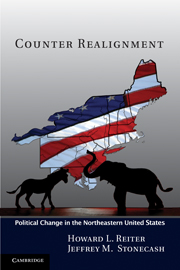Book contents
- Frontmatter
- Contents
- List of Figures
- List of Tables
- Preface
- Acknowledgments
- Postscript: Democratic Fortunes in the Northeast in 2010
- 1 Party Strategies and Transition in the Northeast
- 2 Party Pursuits and the Sources of Change
- 3 The First Republican Losses
- 4 Searching for a Majority, the Rise of Conservatives, and Second Losses
- 5 Interpreting the Goldwater Election and Pursuing the South
- 6 Social Change, Party Response, and Further Republican Losses
- 7 National Parties and the Position of the Northeast
- 8 The Process of Change and the Future
- Index
- References
8 - The Process of Change and the Future
Published online by Cambridge University Press: 05 June 2012
- Frontmatter
- Contents
- List of Figures
- List of Tables
- Preface
- Acknowledgments
- Postscript: Democratic Fortunes in the Northeast in 2010
- 1 Party Strategies and Transition in the Northeast
- 2 Party Pursuits and the Sources of Change
- 3 The First Republican Losses
- 4 Searching for a Majority, the Rise of Conservatives, and Second Losses
- 5 Interpreting the Goldwater Election and Pursuing the South
- 6 Social Change, Party Response, and Further Republican Losses
- 7 National Parties and the Position of the Northeast
- 8 The Process of Change and the Future
- Index
- References
Summary
Over the past 100 years, the Northeast moved from being reliably and heavily Republican to being a region that Democrats could count on as a source of Electoral College votes and congressional seats. The change was a product of the long-term dynamics of policy positioning between the parties as each sought a majority. The process that created this transition tells us much about how change occurs. This conclusion addresses three questions about change.
First, what creates change, and how does change proceed? Is change a product of abrupt shifts in partisan support because of short-term decisions that parties make, or does it occur gradually as a party repositions itself? Do voters shift their loyalties abruptly or does it take them a long time to recognize and react to a party shift? Second, how much does a party anticipate the consequences of its actions? As a party seeks to pursue an expanded electorate, how well does it recognize the consequences of its shifted emphasis on its ability to retain its older base? Do party strategists misjudge or, as the core of the party switches, is the new core willing to sacrifice the older base in the pursuit of greater party homogeneity and cohesion around principle? Third, to speculate, what are the inclinations and prospects for the party to reverse its fortunes in the Northeast?
Information
- Type
- Chapter
- Information
- Counter RealignmentPolitical Change in the Northeastern United States, pp. 167 - 180Publisher: Cambridge University PressPrint publication year: 2011
